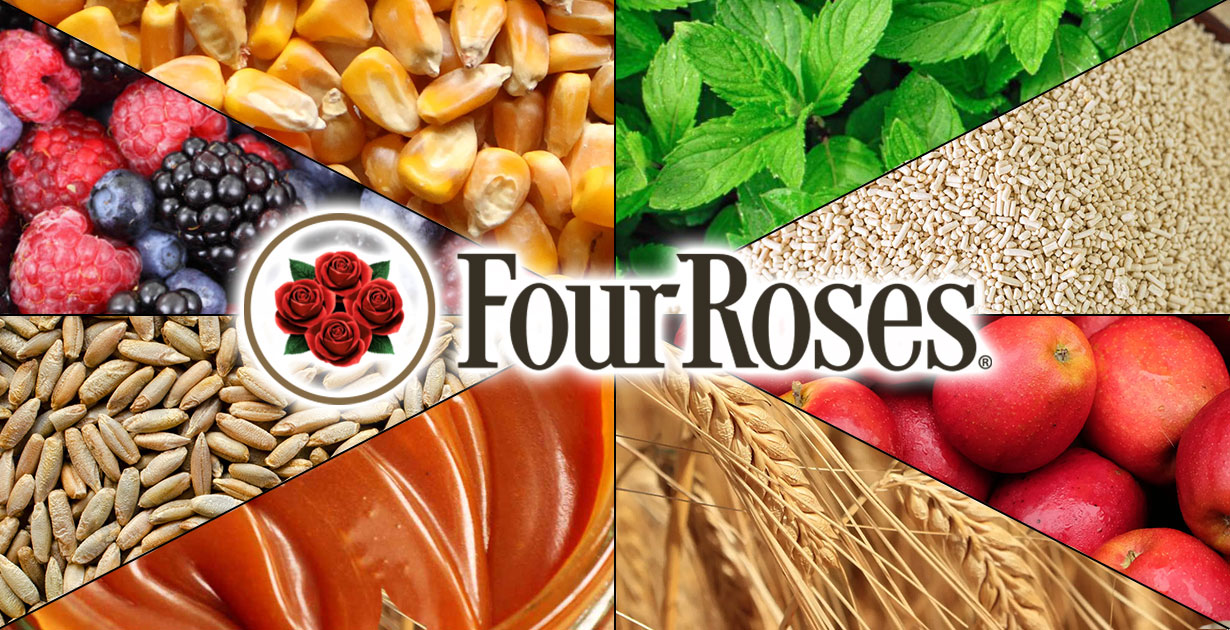
Four Roses is well-known for its ten distinct recipes that each produce different bourbon profiles. Allowing the distillery to cater to a variety of palates and diversify its portfolio, these Four Roses recipes are a point of pride for the brand. But, how exactly does this work?
Let’s take a look at the different yeasts and grains that are combined to create Four Roses recipes, and help you to figure out which recipe you might like the most.
Four Roses’ Mash Bills & Yeast Strains
The basis of Four Roses’ recipes starts with the mash bill. The distillery employs two different mash bills:
- Mash Bill B – 60% corn, 35% rye, and 5% barley
- Mash Bill E – 75% corn, 20% rye, and 5% barley
These two mash bills offer different profiles when distilled into whiskey. For example, the mash bill with the higher rye content – Mash Bill B – will offer a spicier, perhaps earthier profile when compared to Mash Bill E which has 20% rye (this is still considered a high-rye mash bill, but it is not as high as Mash Bill B).
Once the mash bill has been selected, it is time to pick a yeast strain. Four Roses uses five different yeast strains, each of which has been proven to impart different notes to the finished bourbon. These yeast strains, both original and proprietary, are:
- V – Produces notes of delicate fruit
- K – Produces a slight spice
- O – Produces notes of rich fruit
- Q – Produces a floral essence
- F – Produces herbal notes
Using the two different mash bills and five different yeast strains, there are ten possible combinations – and therefore ten different recipes – that can make Four Roses bourbon.
The Ten Recipes
Four Roses’ ten recipes are named as follows:
| Recipe | Profile | Recipe | Profile |
| OBSV | Delicate fruit & rye | OESV | Delicate fruit & caramel |
| OBSK | Rye & baking spice | OESK | Baking spice |
| OBSO | Rich fruit | OESO | Rich fruit & vanilla |
| OBSQ | Rye & light floral character | OESQ | Delicate grains & floral character |
| OBSF | Delicate rye & mint | OESF | Light grain & mint |
The Four Roses recipes are named with a four-letter code, with each letter telling you something about the composition of the recipe. Let’s use recipe number one – OBSV – as an example.
The first letter, ‘O’ tells us that the bourbon was produced at the Four Roses Distillery. Notice that all recipes begin with ‘O’. The second letter, ‘B’, tells us which mash bill has been used. In this recipe, mash bill B, with a higher rye content, is used. ‘S’ is always the third letter, telling us that the whiskey is ‘straight’ whiskey. The final letter ‘V’, tells us which yeast strain has been used. Here, strain V is used, creating notes of delicate fruit.
How Does The Yeast Strain Affect The Flavor Of Four Roses Bourbon?
Yeast plays a huge role in shaping the profile of a whiskey. Whilst yeast is integral to the fermentation process in terms of converting sugars into alcohol, it also produces a number of byproducts that can affect the final flavor of a spirit. The most notable byproducts are esters and phenols. These contribute distinct aromatics and taste characteristics.
Esters are produced when alcohol reacts with acids during fermentation and generally produce light and fruity whiskeys. Phenols are compounds derived from the breakdown of lignin in malted barley or from yeast metabolism. Whilst more common in peated scotch single malts (due to the barley content and use of peat drying) phenols can occur in bourbon and American whiskey. They generally produce woody, spicy, earthy notes.
Different yeast strains produce varying types of esters and phenols, meaning that the distillers at Four Roses can tailor their recipe to the desired profile.
Which Bourbons Use Which Four Roses Recipes?

The bourbons in the brand’s core range, apart from one, are crafted by blending together bourbons of varying Four Roses recipes.
Four Roses Bourbon, the brand’s flagship, is an indulgent blend of all ten Four Roses recipes.
Four Roses Small Batch is made of a blend of OBSK, OBSO, OESK, and OESO, resulting in aromas of sweet oak and caramel, rich berries and spice on the palate, and a lingering finish.
The only bourbon currently on offer using one recipe is Four Roses Single Barrel, which is made from the OBSV recipe. This expression offers “dried spice, pear, cocoa, vanilla, & maple syrup” on the nose, followed by “hints of ripe plum & cherries” on the palate.
Finally, Four Roses Small Batch Select is a blend of OBSV, OBSK, OBSF, OESV, OESK, and OESF. The nose offers raspberries, cloves, and nutmeg. The palate is full of berries, apricot, vanilla, and oak, and the finish is lingering spearmint.
Of course, all such flavors are bolstered by maturation in virgin, charred American oak 53-gallon barrels. Four Roses does not experiment with cask finishes, instead relying on their ten different recipes to craft a variety of delicious bourbons. This focus on yeast sets Four Roses apart from many other whiskey producers. And, if you are a fan of Four Roses, you will know that the proof is in the profile.







